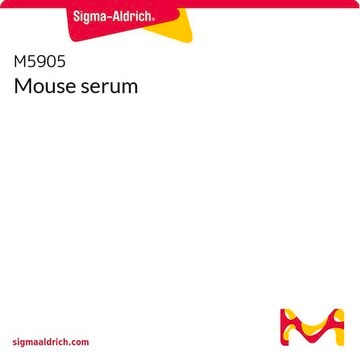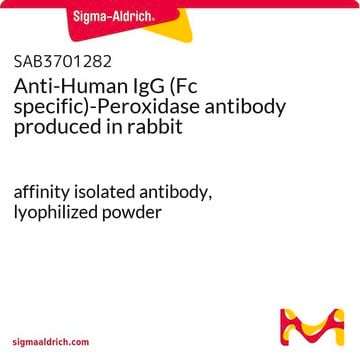推荐产品
生物源
rabbit
品質等級
抗體表格
IgG fraction of antiserum
抗體產品種類
primary antibodies
形狀
liquid
物種活性
(Salmonella enterica typhimurium)
包裝
pkg of 100 μL
pkg of 25 μL
濃度
~1 mg/mL
技術
immunoblotting: 1:2000-1:4000 using Salmonella enterica typhimurium LPS
indirect ELISA: 1:2000-1:4000 using using whole Salmonella
運輸包裝
dry ice
儲存溫度
−20°C
目標翻譯後修改
unmodified
一般說明
Salmonella is a genus of Gram-negative, facultative anaerobe, motile bacillus composed of 2579 different serotypes. Salmonella is considered to be one of the most studied microorganisms as a worldwide foodborne pathogen and a major cause of gastrointestinal human infections.1 S. enterica is a subspecies of S. enterica, that includes 1531 serotypes, among them S. typhimurium and S. enteritidis, responsible for common human illness and thus focus of extensive research.1
特異性
almonella enterica typhimurium antibody recognizes S. enterica typhimurium whole lysate of dead bacteria and S. enterica typhimurium Lipopolysaccharides (LPS), the antibody has no cross reactivity with whole bacterial extracts of E. coli K-12 and E. faecalis.
應用
The antibody may be used in various immunochemical techniques including Immunoblotting and ELISA. Detection of the S. typhimurium bands by Immunoblotting is specifically inhibited by the immunogen.
生化/生理作用
S. typhimurium can survive the acidic environment ofthe stomach through the activation of acid tolerance response (ATR), which maintains the intracellular pH
higher than the extracellular pH.6 Then, S. typhimurium penetrates the mucus barrier of the intestinal wall and adheres to the epithelium to initiate the infection, that may results in diarrhea, loss of electrolytes and local inflammation of the intestine.7-9
After S. typhimurium is being engulfed by enterocytes, it forms intracellular phagosomal compartments, termed Salmonella-Containing Vacuoles (SCV) where the bacterium is able to survive and multiply.2,9 S. typhimurium has various virulence factors, most of them are enoced by genes located in the Salmonella Pathogenicity Islands (SPI).10 S. typhimurium uses flagella for motility after ingestion11 and then type I fimbrae12 and adhesins to adhere to the epithelium. It expresses Type III Secretion System (T3SS) that enables the bacteria to inject into the host cells a variety of effector proteins such as, SipABCD, SptP, SpiC and SopB that alter cellular functions to promote bacterial invasion, survival and propagation.2,13,14 Moreover, S. typhimurium is able to form resistant biofilms15 that contribute to the establishment of chronic, ""carrier state"" infections. In addition, human specific S. typhiis used as a model for the animal study of typhoid fever.16
higher than the extracellular pH.6 Then, S. typhimurium penetrates the mucus barrier of the intestinal wall and adheres to the epithelium to initiate the infection, that may results in diarrhea, loss of electrolytes and local inflammation of the intestine.7-9
After S. typhimurium is being engulfed by enterocytes, it forms intracellular phagosomal compartments, termed Salmonella-Containing Vacuoles (SCV) where the bacterium is able to survive and multiply.2,9 S. typhimurium has various virulence factors, most of them are enoced by genes located in the Salmonella Pathogenicity Islands (SPI).10 S. typhimurium uses flagella for motility after ingestion11 and then type I fimbrae12 and adhesins to adhere to the epithelium. It expresses Type III Secretion System (T3SS) that enables the bacteria to inject into the host cells a variety of effector proteins such as, SipABCD, SptP, SpiC and SopB that alter cellular functions to promote bacterial invasion, survival and propagation.2,13,14 Moreover, S. typhimurium is able to form resistant biofilms15 that contribute to the establishment of chronic, ""carrier state"" infections. In addition, human specific S. typhiis used as a model for the animal study of typhoid fever.16
外觀
Supplied as a solution in 0.01 M phosphate buffered saline pH 7.4, containing 15 mM sodium azide as a preservative.
儲存和穩定性
For continuous use, store at 2-8°C for up to one month. For extended storage, freeze in working aliquots. Repeated freezing and thawing is not recommended. If slight turbidity occurs upon prolonged storage, clarify the solution by centrifugation before use. Working dilution samples should be discarded if not used within 12 hours.
免責聲明
Unless otherwise stated in our catalog our products are intended for research use only and are not to be used for any other purpose, which includes but is not limited to, unauthorized commercial uses, in vitro diagnostic uses, ex vivo or in vivo therapeutic uses or any type of consumption or application to humans or animals.
Not finding the right product?
Try our 产品选型工具.
儲存類別代碼
12 - Non Combustible Liquids
水污染物質分類(WGK)
WGK 1
我们的科学家团队拥有各种研究领域经验,包括生命科学、材料科学、化学合成、色谱、分析及许多其他领域.
联系技术服务部门







